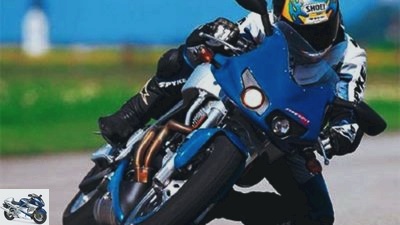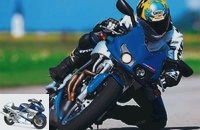Menus

Top test Buell XB9R Firebolt
Rythm and Race
Swap fringed jacket for knee slider? Erik Buell also gives real Harley freaks access to rigorous sportiness, because a refurbished 1000cc Milwaukee twin pulsates unmistakably in the sleek XB9R heating iron.
The sports motorcycles of this world have one thing in common: They want to be tamed, controlled, they appear to be more or less stubborn and individual. Easy-care Japanese of the 600 class leave the command to the rider after a brief hello and three and a half turns, large-caliber bullets require at least one tank of fuel to get a big kick, and Italian twins only really get down to business after a weekend together.
Well then, have fun with the new Buell. Because it combines a short, mercilessly designed for handling chassis with a V2 chunk in a way that the world of athletes has never seen before. It’s almost a miracle that designer Erik Buell was able to squeeze the 92 hp Harley twin into a 1320 millimeter wheelbase without the Dunlop D 207 rubbers colliding with the engine. Unusually inclined, the swing arm, which is only 460 millimeters long, rotates directly in the motor housing, which in turn is connected in elastic rubber bearings and with a sophisticated system of tension struts in the projecting aluminum frame (see photos on page 18). The Americans have garnished the whole thing with a fork installed at a steep 69 degrees and only 83 millimeters of caster, values that were previously reserved for highly agile 250cc GP racers. Need a comparison? The handiest of the current big bikes, the Honda Fireblade, has a steering head angle of 66.3 degrees, 97 millimeters of caster and 1400 millimeters of wheelbase.
In stark contrast to the tiny chassis: the engine, a chunk of gigantic proportions and still in a coarse mechanical design. The most striking change to the old Buell: The bread box flanged on the right-hand side, technically exact name Helmholz resonator, was moved under the dummy fuel tank, the fuel itself is bunkered in the aluminum frame. The XB9R drives your engine oil for a walk in the voluminous rear swing arm. You can see Eric Buell enjoys saving when it comes to weight. The result of his collection of ideas is impressive: 206 kilograms, with a bulging frame, mind you.
Saddled up on the blue playmobile, the conflict becomes really clear. Handlebar stubs mounted far forward and spread a little too far, a short “tank” and a sporty folded walking device leave no room for doubt: Erik Buell is serious about sportiness, even if you definitely feel a certain seating comfort. But then the shock comes when the starter causes the twin to ignite with a mechanical blow, the drive squirms and shakes in its rubber mounts and shakes everything that has to do with the XB9R violently. Driver included. All Harley, nothing more sport. With a lot of pressure and noise, the gearbox was brought into position one. The XB9R rumbles away with a cold start and with an occasional ooooooooooooooooooooooooooooooooooooooooooooooooooooooooooooooooooooooooooooooooooooooooooooooooooooooooo man In return, the waves of the vibrations above the idle speed smooth out into slightly rippled chirping and rattling from the monstrous unit.
When gliding briskly, the V2 flatters itself with smooth draft and with the throttle valve wide open, it also flatters itself with a robust bollern. Just Harley. A sporty gallop, however, is not possible with the tired idea of less than 4000 rpm, if you are looking for dynamic you will only find it above it. Then the 1000 cc engine gives everything, thanks to a very short overall gear ratio, pushes horse and rider forward tremendously and sputters into the limiter at 7500 rpm because of the sheer “Let me too”. So, and whoever presses into the next gear in cold blood and callously at that moment will be jerked off his stool by the powerful flywheel mass of the motor. It shakes the whole load badly and embarrasses the pilot.
The other way around, too, are the huge centrifugal masses of the crankshaft and the braking torque of the V2. For example, when a gear change down in long bends or when braking hard is pending. Just step through and let the clutch snap? The Buell’s response to such a brazen approach comes immediately and brings a considerable stir in the pews. No, ladies and gentlemen, not like that – not with a Buell. This is where the sensitive machinist is needed, shirt-sleeved heaters have no place on the XB9R. Only those who tune the sturdy engine with gentle double-declutching to the right speed, who take the time to shift gears, who keep the river flowing, will the pleasant sides of the American temptation open up. And that takes time, patience, mile after mile.
Despite Erik Buell’s honest efforts to ensure handiness and dynamism, the XB9R never has the cheerful lightness of a disdainful Japanese racing roll. No, this engine will not set a lap record in any sports suspension in the world even in a hundred years. Even a sumo wrestler does not become a prima ballerina just because he squeezes his fat quanta into ballet shoes. Here as there, the strength lies in calm. In areas with long curves, for example, when the enormously front-heavy Buell draws its bow in stoic calm, the front wheel neatly shows the track that gives the XB9R something of that sticky-safe Ducati feeling.
If medium-sized bumps get in the way, the rest is over. And on the longitudinal grooves the feeling arises as if the front and rear wheels are taking advantage of the freedom of movement of the split frame concept and are going their separate ways without further ado. If the curves become narrower and more wavy, a close cooperation between man and machine is advisable. With a firm knee and a clear command by pressing the handlebars, the duo masters such challenges with a lot of fun and even a little sportiness. Hanging-off, the real athlete’s game, doesn’t do much? except restlessness. And you can’t use it in the narrow space, because the XB9R still has a peculiarity to be taken seriously.
Braking in an inclined position or when gently turning in the Buell inevitably force it into a vertical position. And that in a way that even unruly athletes have not yet known. The committed rider powerlessly tries to impose the will on the horse. Vain. You take the big bow and dash around the corner on a line that you hadn’t thought of. Although this thing must be dealt with with patience and spit. The 375 millimeter brake grips confidently and with good controllability, but lifts the rear wheel off the ground too early. So early that the determined braking distance extends to a whopping 43.3 meters.
A.As a result of the idiosyncratic quirks and edges of the Buell, a driving style develops that avoids tackling several things at once. One after the other: clutch – double-declutch – brake – then turn in and accelerate cleanly on the way. No rush, no rush. Speed and fun come naturally when you understand this motorcycle, let it run, accept that you are not up to the force of the crankshaft gyro. And then, there’s no stopping it. Because growing together with this Buell, mastering physics, the harmonious interplay of man and machine, creates the charm that the slippery everyday motorcycles simply lack for all their perfection.
Buy complete article

Top test Buell XB9R Firebolt
Rythm and Race
News & Facts
PlusEasy-care toothed belt drive that does not have to be retightenedVery easy dismantling of the precisely fitting plastic partsConsistently good workmanship and clever detailed solutionsVery independent and innovative overall concept MinusDeveloped handlebar flutter (Shimmy) between 80 and 110 km / hPoor visibility in the rearview mirrors that are too small Therefore in the damping after Confusing, playful dials on the speedometer and tachometer, tank cap cannot be folded, oil control and refilling inconvenient, annoying loud fan noise of the engine cooling after switching off the ignition, suspension settings fork: spring base 4 rings visible, level 2 rings visible, student damping ¾ (1 1/2) turn open, Compression stage 1 (2) turns open. Strut: spring base 2nd position, rebound stage ¾ (1 ½) turns open, compression stage 1/2 (2) turns open. (Values in brackets for comfortable country road operation)
MOTORCYCLE readings
Braking measurement Braking distance from 100 km / h 43.3 meters Average deceleration 8.9 m / s 2 Comments: Despite the very effective braking system, the Buell does not come off the beaten track. The rear lift off early requires a lot of balance and extends the braking distance to over 43 meters. Handling-Parcours I (fast slalom) Best lap time 21.3 secVmax at the measuring point 102.3 km / h Comments: The Buell requires a lot of physical effort and a very tight suspension setting in order to circle precisely through the pylons. When braking into the turning point, she stands up vehemently and has to be forced onto the narrow line with a firm knee grip. Handling course II. (Slow Salalom) Best lap time 29.0 secVmax at the measuring point 53.4 km / h Comments: as in the fast slalom Here, too, a tight coordination helps to achieve more stability when changing lean angles and loads. The Buell tends to understeer in large lean angles and then pushes over the front wheel.Circular orbit 0 46 metersBest lap time 10.5 sec Vmax at the measuring point 52.2 km / h Comments: Unrestricted ground clearance allows large lean angles, but the Buell pushes over the front wheel. Bumps in the slope create a lot of unrest and force the XB9R off the targeted line.
Conclusion
Trying to bake a racing roll out of a Harley was worth it. The project was not entirely successful, but that is also pretty short. Because the XB9R has effortlessly made it into the headlines, embroiling the MOTORRAD editorial team in great excitement and impulsive disputes. Beyond the 1000 point rating, the Buell has only won.
Related articles
-
Artist 14 paintings Buell 1/14 … and Midnight Black. Buell 2/14 The Cafe Racer Buell 1125 CR is available in the fashionable colors Racing Red … Buell 3/14 …
-
Comparison test two-cylinder: BMW R 1200 R, Buell Lightning XB12Ss and Moto Guzzi Griso 8V
fact comparison test two-cylinder: BMW R 1200 R, Buell Lightning XB12Ss and Moto Guzzi Griso 8V Big Twins only 1170, 1202, 1151 ?? these…
-
Long-term test Buell Lightning XB12S (interim result)
Artificial long-term test Buell Lightning XB12S (interim balance) Buell machines are certainly not off the peg Mass-produced goods. The more interesting the …
-
Top test Harley-Davidson VRSCA V-Rod
fact Top-Test Harley-Davidson VRSCA V-Rod Emotional rescue Words are missing. At least the Germans. Because just at the time when the …
-
Top test Buell XB12S Lightning
Gargolov Top-Test Buell XB12S Lightning The Pit-Buell A Pit Bull and an XB12S have a lot in common. Also that they are basically lamb-pious …
-
Endurance test final balance Buell Lightning XB12S
Bilski endurance test final balance Buell Lightning XB12S Prima Donner This is how they are, the Buells: capricious like prima donnas. But the dull rumble of the XB12S …
-
Jorg Kunstle comparison test two-cylinder: BMW R 1100 S Boxer-Cup-Replika, Buell Firebolt XB9R, Ducati SS 1000 DS, Moto Guzzi V11 Le Mans Rosso Corsa Feel …
-
Driving report Buell Firebolt XB9R
Driving report Buell Firebolt XB9R It ?? s a Buell! Big Harley-V2 in a compact sports chassis? and an exhaust the world has never seen. There! It…
-
Naked bikes in the test: Aprilia, Benelli, Buell, Yamaha
Art 20 pictures Aprilia 1/20 New design, modernized engine: Tuono 100 R, year 2006. Aprilia 2/20 New design, modernized engine: Tuono 100 …
-
Jahn Top test Buell Ulysses XB12X Up, up ?? and away Robust technology for rough motorcycle adventures: With the Ulysses, Erik Buell makes a very…